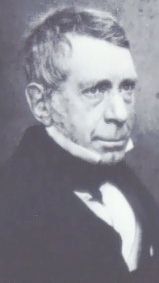|
|
AIRY TELLS
THE TRUTH
QUIZ QUESTION: What was it, according to Sir
David Brewster, ‘' ... which no Englishman can peruse without
unmingled pain’? (North British Review 1847 7, p226)
ANSWER: Airy’s letter to Leverrier of
October 21st, 1846 .
 Airy
wrote to Leverrier on the 14th of October congratulating him, ‘You
are to recognized beyond doubt as the real predictor of the planet’s
place,’ then added a week later on the 21st: Airy
wrote to Leverrier on the 14th of October congratulating him, ‘You
are to recognized beyond doubt as the real predictor of the planet’s
place,’ then added a week later on the 21st:
‘no person in England will dispute the completeness of your
investigations, the sagacity of your remarks on the points it was
important to observe, and the fairness of your moral convictions
as to the accuracy and certainty of the results. With these things
we have nothing which we can put in competition. My acknowledgement
of this will never be wanting; nor, I am confident, will that of
any other Englishman who really knows the history of the matter.’
Airy did really know the history of the matter. This letter was
(naturally enough) soon printed in Comptes Rendues by Arago, at
which Airy complained (letter to Arago, 26th). However, he was the
Astronomer Royal. He suffered much from the publication of this
letter.
A month later, in his address to the RAS (Nov. 13th) Airy compared
Leverrier to Copernicus:
'since Copernicus ... nothing (in my opinion) so bold, and so justifiably
bold, has been uttered in astronomical prediction. It is here, if
I mistake not, that we see a character far superior to that of the
able, or enterprising, or industrious mathematician; it is here
that we see the philosopher. The mathematical investigations will
doubtless be published in detail and they will, as mathematical
studies, be highly instructive; but no details published after the
planet's discovery can ever have for me the charm which I have found
in this abstract [Leverrier's memoir] which preceded the discovery.'
A stark contrast is here made with Adams as the mere 'industrious
mathematician' who only published his results after the discovery.
Of this presentation Smart (amongst others) complained, ‘Airy’s
account contained several extraordinary passages, full of the liveliest
admiration for LeVerrier and almost completely destitute of but
the barest recognition of Adams’ achievement’ (p68).
However, Smart reassured his readers, the verdict of history had
been ‘far different.’
One might have expected the British people to accept the firm and
twice-stated views of their own Astronomer Royal upon this subject,
but, alas, they did not - far from it. Airy was severely castigated
on all sides, such that the Neptune affair 'seemed unduly to overshadow
him for the rest of his life’ (W.Ellis, The Observatory 1905
28 p.184). His six-hundred page autobiography contained only one
(bitter) paragraph about Neptune! For more on Airy's candid opinion
see "Airy Blows His Top".
Hatching the Plot
Francois Arago, director of the Paris Observatory, had the highest
respect for Airy's integrity. 'Ceux qui connaissent M.Airy n'eleveront
certainement aucun doute sur la verite de sa declaration' (Comptes
Rendues 19 Oct 1846, p.752): 'Those who know Mr Airy cannot harbour
any doubt over the veracity of his word.' Thereby Arago argued against
the British case, and used Airy’s letter to Leverrier on June
26th in this context. From this letter it appeared quite evident
that its author Airy had no clue about how Uranus' distance ('radius
vector') would be affected by an unknown planet's perturbation,
and Leverrier had to explain the matter to him. This was the first
English response to Leverrier's June prediction. Airy was, as Arago
explained, one of the most highly informed persons on the subject
of celestial mechanics; and, after all, supposedly had Adams' prediction
‘in his hand’. Arago was thereby resting the entire
French case upon Airy's integrity. In this, he went too far.
In their commendible account of events Baum and Sheenan state, 'Airy's
actions or inactions, with which one can sympathise up to this point,
now become somewhat inscrutable' (1997, p.99). Likewise, Turner
in 1904 had experienced a 'difficulty in understanding Airy's conduct'
at this point (p.62). Airy was, quite simply, plotting, to secure
the planet for England.
Airy's Portrait courtesy Royal Astronomical Society
|

